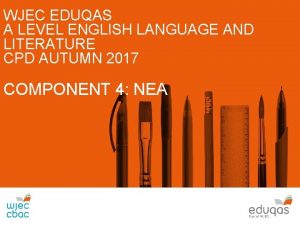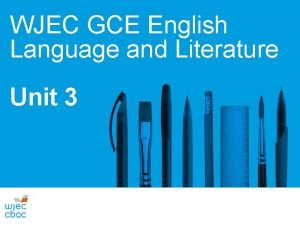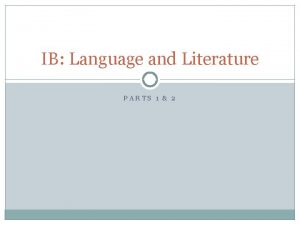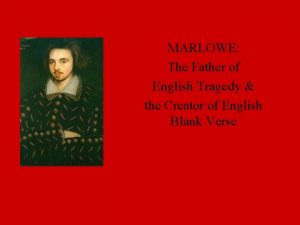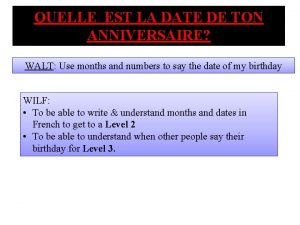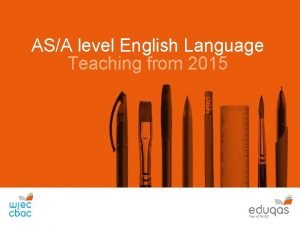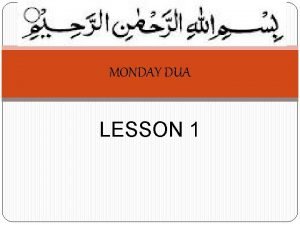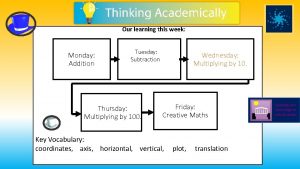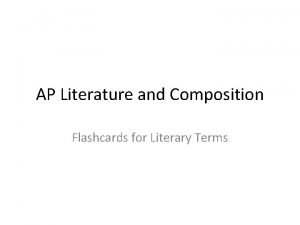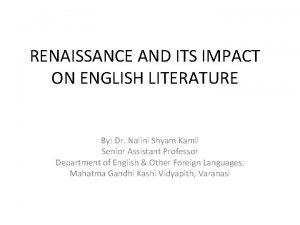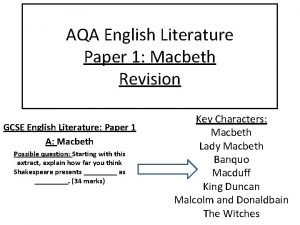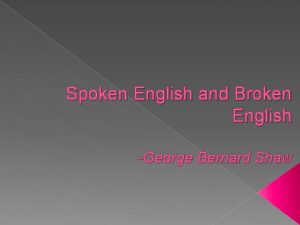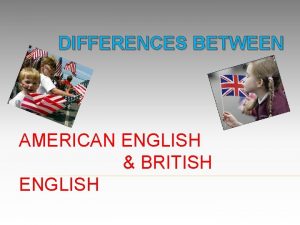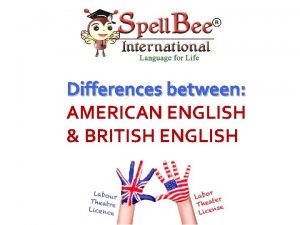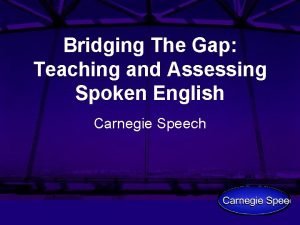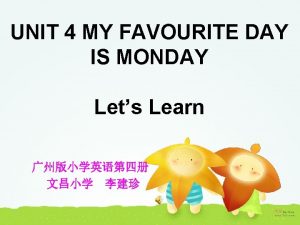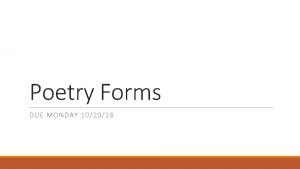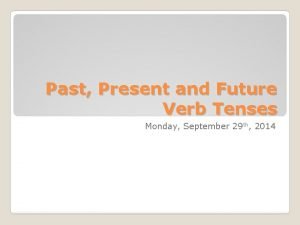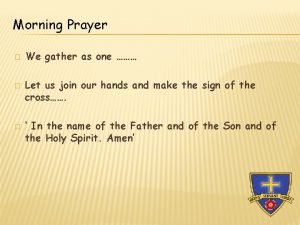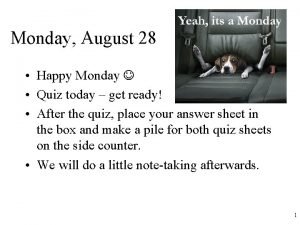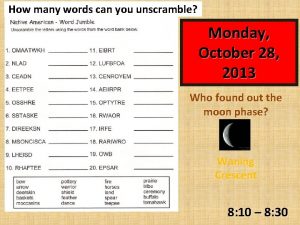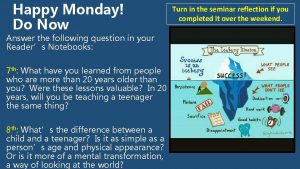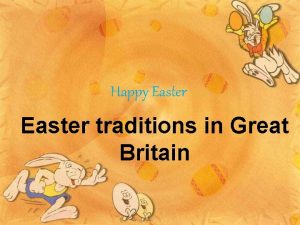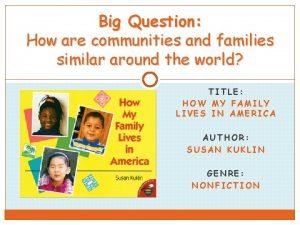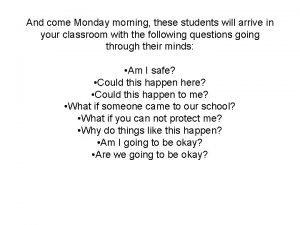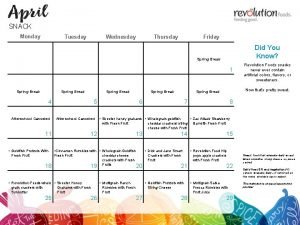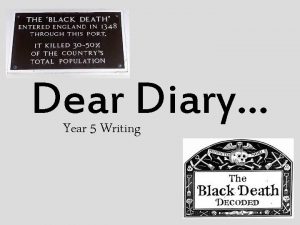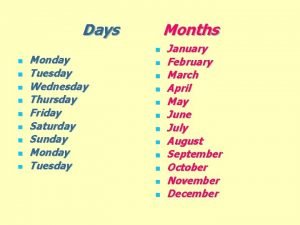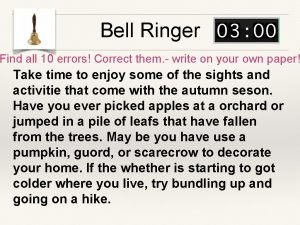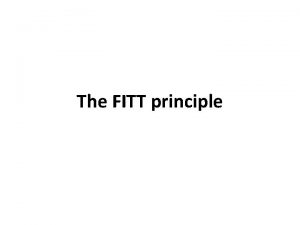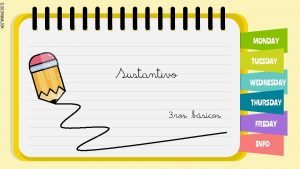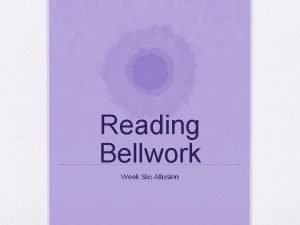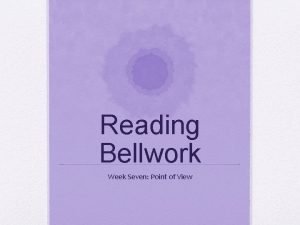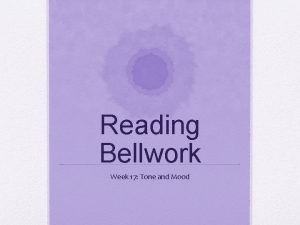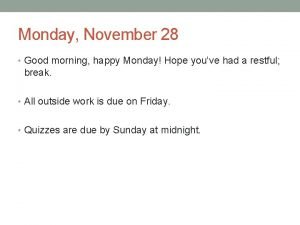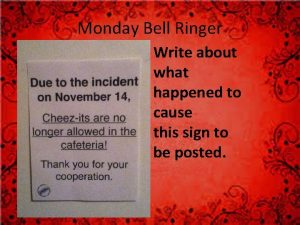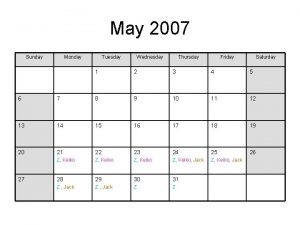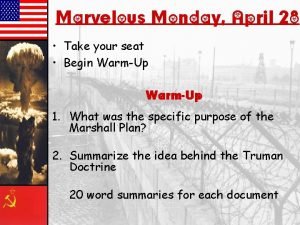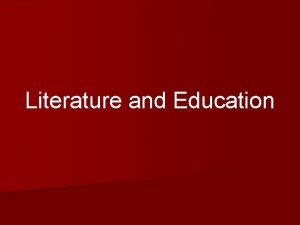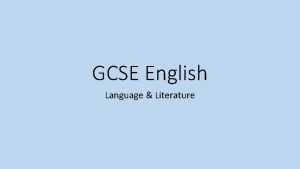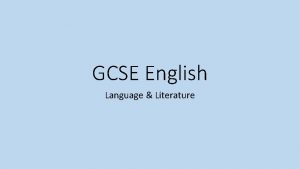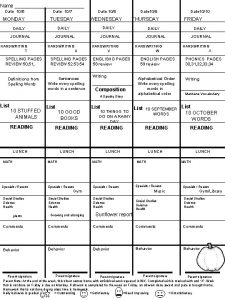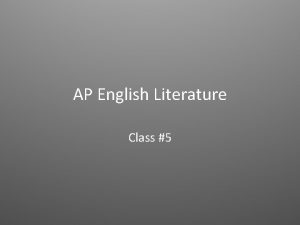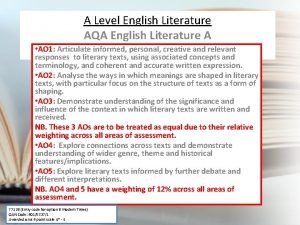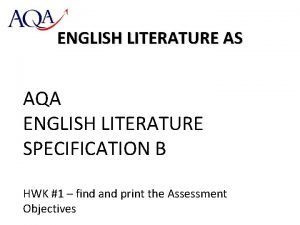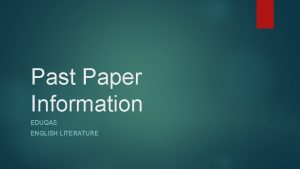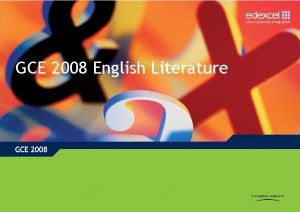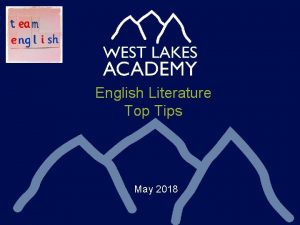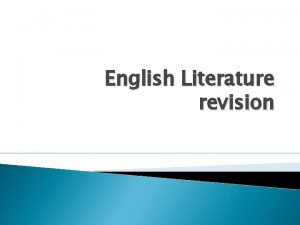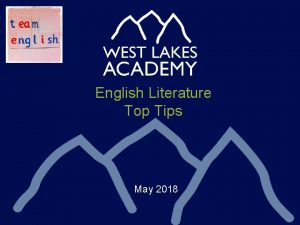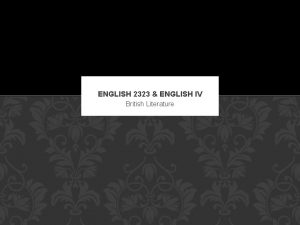Y 12 English Language and Literature Date Monday

































































- Slides: 65

Y 12 English Language and Literature Date: Monday and Tuesday 9 th May 2017 Teacher: Mr Cole-Savidge Room: 117 L. O. : to assimilate key aspects of research throughout the unit and to prioritise areas of revision in preparation for your exam Exam 1 – (AM) Friday 19 th May - (7706/1) – Views and Voices (Imagined Worlds, Poetic Voices) Exam 2 – (PM) Wednesday 24 th May – (7706/2) – People and Places (Remembered Places, Re-creative Writing)

AS: Specification at a glance Slide 6 Copyright © AQA and its licensors. All rights reserved.

Assessment objectives AO Description AO 1 Apply concepts and methods from integrated linguistic and literary study as appropriate, using associated terminology and coherent written expression Frameworks terminology AO 2 Analyse ways in which meanings are shaped in texts Analysis of texts AO 3 Demonstrate understanding of the significance and influence of the contexts in which texts are produced and received AO 4 Explore connections across texts, informed by linguistic and literary concepts and methods connections AO 5 Demonstrate expertise and creativity in the use of English to communicate in different ways Creativity Slide 9 Copyright © AQA and its licensors. All rights reserved. context


Read Text A (‘Breathless: An American Girl in Paris’ (Nancy Miller) from the chapter ‘Waiting For Godard’) and Text B (‘Travelling to Paris with a grandchild’ (Gransnet)). Compare and contrast how the writers and speakers in these extracts present Paris. You should refer to both extracts in your answer and consider the language choices made and their likely effects, the different audiences and purposes of the texts, and aspects of mode. WWW EBI

English Language and Literature Key terms Glossary Literary and Phonology Stylistic Discourse Grammar/Syntax Lexis/Semantics Pragmatics Simile Metaphors Repetition Personification Rhetorical question Symbols and motifs List of three Hyperbole Anecdote Turn taking Adjacency pair Cooperative/competitive overlapping ( when people speak over each other) Interruptions ( when one person interrupts another’s turns and speaks) Violation of turn taking Holding the floor Goal orientation Tag interrogatives Imperatives Declaratives Exclamatives Interrogatives Adjectives/Verbs Ellipsis Lengths of sentences Clauses – subordinate clauses Abstract nouns/Concrete Modal verbs Phatic talk Irony Connotations Euphemism Back channelling Sarcasm Humour Puns (double meaning) hedging Alliteration Onomatopoeia Sibilance Plosives Pre/post modifiers (all adjectives and adverbs) Semantic fields Connectives Elision Colloquialism/ Standard English Idiolect Pronouns What types of texts does the Anthology contain? Travel memoirs Advertisements Video travel guides Personal narratives Autobiographies Online guides Websites – online forums Guidebooks Newspaper articles Pathe news reports Letters Conversations History books Travel blogs

Definitions Literary and Stylistic • Simile - a figure of speech involving the comparison of one thing with another thing of a different kind, used to make a description more emphatic or vivid. • Metaphors - a figure of speech in which a word or phrase is applied to an object or action to which it is not literally applicable. • Repetition - the action of repeating something that has already been said or written. • Personification - the attribution of a personal nature or human characteristics to something non -human, or the representation of an abstract quality in human form. • Rhetorical question - a question asked in order to create a dramatic effect or to make a point rather than to get an answer. • Symbols and motifs - A symbol is a mark, sign, or word that indicates, signifies, or is understood as representing an idea, object, or relationship. A motif is a dominant or recurring idea in an artistic work. • List of three - The rule of three is a writing principle that suggests that things that come in threes are funnier, more satisfying, or more effective than other numbers of things. The reader or audience of this form of text is also thereby more likely to remember the information. • Hyperbole - exaggerated statements or claims not meant to be taken literally. • Anecdote - a short amusing or interesting story about a real incident or person.

Definitions Phonology (speech sounds) • Alliteration - he occurrence of the same letter or sound at the beginning of adjacent or closely connected words. • Onomatopoeia - the formation of a word from a sound associated with what is named. • Sibilance - is a literary device where strongly stressed consonants are created deliberately by producing air from vocal tracts through the use of lips and tongue. Such consonants produce hissing sounds. • Plosives - a plosive speech sound. The basic plosives in English are t, k, and p (voiceless) and d, g, and b (voiced).

Definitions Discourse (Discourse has various definitions but one way of thinking about it is as any piece of extended language, written or spoken, that has unity and meaning and purpose. ) • Turn taking - Turn-taking is a type of organization in conversation and discourse where participants speak one at a time in alternating turns. (Counterpoint = violation of turn taking). • Adjacency pair - An adjacency pair is a unit of conversation that contains an exchange of one turn each by two speakers. • Cooperative/competitive overlapping – when people speak over each other. • Interruptions – when one person interruptions another’s turn and speaks. • Holding the floor - to speak to a group of people, often for a long time, without allowing anyone else to speak • Goal orientation - individual disposition toward developing or validating one's ability in achievement settings. • Saving face - to one's own sense of dignity or prestige in social contexts (relates to Politeness Theory and Face Negotiation Theory).

Definitions Grammar/syntax • Tag interrogatives - A question tag or tag question (also known as tail question) is a grammatical structure in which a declarative statement or an imperative is turned into a question by adding an interrogative fragment (the "tag"). For example, in the sentence "You're John, aren't you? ", the statement "You're John" is turned into a question by the tag "aren't you". • Imperatives – command verb. An imperative sentence or command tells someone to do something (and if done strongly may be considered both imperative and exclamatory): "Go to work. " or "Go to work !" • Declaratives - A declarative sentence or declaration, the most common type, commonly makes a statement: "I have to go to work. " • Exclamatives - An exclamatory sentence or exclamation is generally a more emphatic form of statement expressing emotion: "I have to go to work!" • Interrogatives - An interrogative sentence or question is commonly used to request information—"Do I have to go to work? " • Adjectives/verbs – describing words/doing words. • Ellipsis - is a series of dots (…) that usually indicates an intentional omission of a word, sentence, or whole section from a text without altering its original meaning, or the long passing of time. • Lengths of sentences – one word, simple, compound, complex. • Clauses – subordinate clauses - modify the independent clause of a sentence or serve as a component of it • Abstract nouns/concrete - Concrete nouns refer to physical entities that can be observed by at least one of the senses (for instance, chair, apple, Janet, rock, tree, universe or atom). Abstract nouns, on the other hand, refer to abstract objects; that is, ideas or concepts (such as justice or hatred). • Modal verbs A modal auxiliary verb gives information about the function of the main verb that it governs. Modals have a wide variety of communicative functions, but these functions can generally be related to a scale ranging from possibility ("may") to necessity ("must"), in terms of one of the following types of modality: - epistemic modality, concerned with theoretical possibility of propositions being true or not true (including likelihood and certainty) - deontic modality, concerned with possibility and necessity in terms of freedom to act (including permission and duty) - dynamic modality, which may be distinguished from deontic modality, in that with dynamic modality, the conditioning factors are internal – the subject's own ability or willingness to act. The following sentences illustrate epistemic and deontic uses of the English modal verb must: - epistemic: You must be starving. ("It is necessarily the case that you are starving. ") - deontic: You must leave now. ("You are required to leave now. ")

Definitions Lexis/semantics • Pre/post modifiers (all adjectives and adverbs) - In academic writing, most nouns are preceded or followed by one or more words or phrases known as modifiers. In many cases, nouns have both pre-modifiers (occurring before the noun) and post-modifiers (occurring after the noun). • Semantic fields - a lexical set of semantically related items, for example verbs of perception. • Connectives - a word or phrase whose function is to link other linguistic units. • Elision - the omission of a sound or syllable when speaking • Colloquialism/Standard English – varying levels of formality. • Idiolect - the speech habits peculiar to a particular person. • Pronouns - a word that can function as a noun phrase used by itself and that refers either to the participants in the discourse (e. g. I, you ) or to someone or something mentioned elsewhere in the discourse (e. g. she, it, this ).

Definitions Pragmatics • Phatic talk - Phatic communication is verbal or non-verbal communication that has a social function, such as to start a conversation, greet someone, or say goodbye, rather than an informative function • Irony - the expression of one's meaning by using language that normally signifies the opposite, typically for humorous or emphatic effect. • Connotations - an idea or feeling which a word invokes for a person in addition to its literal or primary meaning. • Euphemism - a mild or indirect word or expression substituted for one considered to be too harsh or blunt when referring to something unpleasant or embarrassing. • Back channelling - The predominant channel is that of the speaker who directs primary speech flow. The secondary channel of communication (or backchannel) is that of the listener which functions to provide continuers or assessments, defining a listener's comprehension and/or interest. • Sarcasm - the use of irony to mock or convey contempt. • Humour - the quality of being amusing or comic, especially as expressed in literature or speech. • Puns (double meaning) - a joke exploiting the different possible meanings of a word or the fact that there are words which sound alike but have different meanings. • Hedging - a joke exploiting the different possible meanings of a word or the fact that there are words which sound alike but have different meanings.

Paper 2 People and Places Section A Remembered Places: key terms and concepts Key terms for this section are Genre: a way of grouping texts based on expected shared conventions Can you give a definition for each of these terms? Representation: the portrayal of events, people and circumstances through language and other meaning-making resources to create a way of seeing the world Point of view: the perspective(s) used in a text through which a version of reality is presented Register: a variety of language that is associated with a particular situation of use Literariness: the degree to which a text displays ‘literary’ qualities along a continuum rather than being absolutely ‘literary’ or ‘non-literary’ Slide 25

Paper 2 People and Places Section B: re-creative writing (AS only) Students should be encouraged to • consciously shape their narratives, and work with particular genre conventions • creatively re-cast texts to take on the role of a writer presenting a place, controlling interpretative effects through considered language choices • analyse their own re-creative writing closely and confidently, drawing on a range of frameworks to support their analyses. Key terminology: Recast: to reshape a text into an entirely new and original piece Slide 27 Copyright © AQA and its licensors. All rights reserved.

Paper 2 People and Places Section B: AS re-creative writing task Question from the specimen assessment material Refer to Text A from The Most Beautiful Walk in the World: A Pedestrian in Paris by John Baxter. Recast this as the section of the Café Danton’s website where the café’s location is described. You might consider: • what will appeal to visitors about the location • how the local area might best be described. You should write about 200 words. Slide 28

Paper 2 People and Places Section B: AS re-creative commentary task Identify four specific examples of language in your writing and explain your reasons for using them. You should write about 200 words. Slide 29 AO 2 (5 marks) • Analyse ways in which meanings are shaped in texts AO 3 (10 marks) • Demonstrate understanding of the significance and influence of the contexts in which texts are produced and received AO 5 (5 marks) • Demonstrate expertise and creativity in the use of English to communicate in different ways



What is the examiner looking for? Look at an indicative contents on a past mark scheme AO 3: AO 1: Text A • context of tourism (Text A) • knowledge of Paris streets and culture (boulevard Saint-Germain) (Text A) • use of first person narrator and past tense to recount experience • use of third person pronouns ‘they’, ‘them’ to present the walkers as ‘others’ • use of simple/orthographic sentences for effect ‘The walkers’ • conventions of the memoir (Extract A) • likely situation of viewing and opportunity to view on a number of devices – tablet, smartphone, laptop (Extract B) • negatively-oriented lexis to describe the walkers, ‘uncertain’, ‘huddled’ • representation of tourists as out of place in Paris. Indicative Content • reasons why readers and viewers might want to read the extracts (Extracts A and B). AO 4: Text B • use of third person narrator • shifts from present to past tense to explain history • similarities and differences in likely readerships and situations of reading • similarities and differences in purpose and genres of texts (Text A: a memoir, Text B: to inform but also to persuade - both to visit France and to • use of second person pronoun to directly address the viewer buy more of the video company’s products) • instructional/invitational verb phrases – ‘take’, ‘stroll’ • ways in which Paris is made to appear attractive • lexical choices made to influence viewer and present Paris as attractive – ‘epitome of romance’, ‘each with its own personality’, ‘grand boulevards’ • distinction between own culture/society and Paris • use of well-known proper nouns related to Paris and France to give authority to video – ‘Louvre’, ‘Arc de • Paris as intriguing and worthy of narrative attention Triomphe’, ‘Napoleon’. • any other connections that are linked by narrative presentation and conventions.

Example Answer Text A’s main purpose as an account is to entertain and inform. On the other hand, Text B’s main purpose is to guide and similarly inform with a secondary purpose to entertain. Text A entertains through its use of humour and metaphors. The writer refers to the cemetery as “a fashionable address for the afterlife. ” This is funny because we associate addresses as places where the living live which is ironic because it is where the dead live. It also serves its other main purpose to inform by using facts such as “ 1804” and listing who is buried there. The list contains a semantic field of the famous dead “Gertrude Stein, Edith Piaf, Oscar Wilde, Pissarro and Proust. ” Similarly, Text B has a main purpose of informing and also used lists to present famous works of art. The semantic field of art work is appropriate because the Louvre is an art museum. Text A is mainly targeted at adults who enjoy nonfiction travel writing as a literary form. Whereas text B is for travellers who are planning to visit the Louvre museum. Text A in order to meet the demands of its audience uses adjectives which create a picturesque scene of the cemetery. Adjectives such as, “winding” and “tree lined” create a semantic field of a beautiful city scape. The audience who may be armchair travellers may not have seen the place and these adjectives create a vivid powerful description of the cemetery for them to imagine. It makes the cemetery ironically seen as romantic. Text B engages with the audience and builds a relaxed relationship through the use of synthetic personalisation. He does this through an informal greeting “hi” and the use of his first person pronoun “I” to refer to himself and the second person pronoun “you” to refer to the audience. By using the second person pronoun “you” it almost feels as if he is building an intimate relationship with one listener. Because this is meant to be heard because it is a podcast, Rick Steve’s voice which will be heard through an earphone piece will seem like a friendly personal guide talking them through their own private tour.






Articles Stories are Waiting in Paris (Eurostar) X Ten Things My Kids Say They Will Miss About Paris (Just Another American in Paris) X Mile by Mile London to Paris (extract) (R. Pigott and M. Thompson) X Travelling to Paris with a grandchild (Gransnet) X Neither Here Nor There: Travels in Europe (extract) (Bill Bryson) X Paris for Children (extract from the Rough Guide to Paris (Rough Guides) X The Most Beautiful Walk in the World: A Pedestrian in Paris (extract) (John Baxter) X Introduction (extract from NOT-FOR-PARENTS: PARIS – Everything you ever wanted to know) (Klay Lamprell) X Personal narrative: Anna X Inside Out and Upside Down (extract from NOT-FOR-PARENTS: PARIS – Everything you ever wanted to know) (Klay Lamprell) X Personal narrative: Zara X Dem Bones (extract from NOT-FOR-PARENTS: PARIS – Everything you ever wanted to know) (Klay Lamprell) X Breathless: An American Girl in Paris (extract) (Nancy Miller) X Cruise the Carousels (extract from NOT-FOR-PARENTS: PARIS – Everything you ever wanted to know) (Klay Lamprell) Around the World in 80 Dates (extracts from City Lit Paris) (Jennifer X Cox) On Paris (extract) (Ernest Hemingway) What do you wish someone had told you – Paris Iile de France (Trip X Advisor) Foreign Correspondent: Paris in the Sixties (extract) (Peter Lennon) Visiting Paris (Mike and Sophia) Paris Riots 1968 (British Pathe) Rick Steves’ Walking Tour of the Louvre Museum (Rick Steves) X Seven Ages of Paris (extract) (Alistair Horne) French Milk (extract) (Lucy Knisley) X Letters From France 1790 -1976 (extract from Travel Writing 1700 -1830: An Anthology) (Helen Maria Williams) Understanding Chic (extract from Paris was Ours) (Natasha Fraser. Cavassoni) X Paris: Fine French Food (Lonely Planet) Memories of Places in Paris (Isabelle and Sophia) X The Sweet Life in Paris: Delicious Adventures in the World’s Most Glorious and Perplexing City (extract) (David Lebowitz) Encore Une Fois (Just Another American in Paris) 18 Months Later… (Just Another American in Paris) Eating in Paris (Isabella, Mike and Sophia x X x

Main themes throughout the Anthology • To be truly ‘Parisian’. • French cultural references – liberal, Jewish, French New Wave films, Renaissance painting history • Chic fashion • The tourist’s perception

Stories are Waiting in Paris (Eurostar) • Mode – Spoken, Standard English, multi-modal. Genre – Video Advertisement. Audience – Tourists, travellers to Paris. Purpose – to advise and to promote. • Plosive syllables to create strong sounds with word selection. • Repetition – “maybe” – encourages possibilities and chance. • Planned pauses – dramatic punctuation. • Sibilance – “kissing” – emphasising that Paris is the ‘city of love’.

Mile by Mile London to Paris (extract) (R. Piggott and M. Thompson) • Mode – Written (formal) Genre – Non-fictional, historical Audience – Older demographic (including historians) Purpose – to inform and entertain • Declaratives – “it has a long and interesting history” – statements of authority to emphasise the critical formality of the writing. • Adjectives – “golden arrow” – explaining the look. • Mood/tone – functional and matter-of-fact.

Neither Here Nor There: Travels in Europe (extract) (Bill Bryson) • Mode – Written (varying formality) Genre – Memoir (travel writing) Audience – Tourists, literature enthusiasts Purpose – to entertain and to inform • Whimsical writing style – mild swearing for comedic shock factor - “shit” - varying levels of formality (from blunt to formal and vice versa in a matter of sentences) • Short, sharp sentences – “there’s too much traffic” – he judges and analyses places he visits (expert travel writer). • Repetition of emotive language (adjectives and adverbs) – “foolishly…aggressive…weakly…wimpering” – expressive writing style.

How does Bryson present Paris? Bryson presents Paris as a chaotic city full of hustle and bustle. Bryson uses a series of dynamic verbs “swishing”, “flying” and “hurrying” to convey the city’s frenzied nature created by its transportation system and the people moving within it. The layering of dynamic verbs within this complex sentence emphasises the speed in which the city and its people move. Bryson’s uses a simile describing people “flying out of Metro stations like flocks of startled birds”, suggesting a level of wild panic in the mornings. Now, write your own analytical paragraph answering the question above. Remember to use relevant terminology (AO 1). Success Criteria: 1. Accurate linguistic terminology throughout 2. Embedded quotations 3. Answer question clearly in point 4. Multiple interpretations of evidence 5. Can develop analysis with another quote 6. Always find something interesting to say about the language – meanings/ effect on audience/ different interpretations

The Most Beautiful Walk in the World: A Pedestrian in Paris (extract) (John Baxter) • Mode – Written, formal, sophisticated Genre – Literary Audience – those searching to become Parisian Purpose – to inform and to entertain • Quote from Charles Gros (“splendour of the landscape”) to give the article a grandiose philosophical signpost. • Variety of sentence structures for dramatic emphasis. • Declaratives – “At number 12, Sylvia Beach ran Shakespeare and Company” – factual information to inform and create a contextual understanding of Paris. • Many geographical references of Parisian locations – in italics – shows the writer’s expertise and knowledge about the city. • Alliteration – “Brooklyn, Brettwood and Birmingham” – snappy writing style. • Humility of the writer – “I feel like a fraud” – shows that he sometimes does not match the myth of what it is to be ‘Parisian’.

Paris City Guide (Lonely Planet) • Mode – Spoken (script) – high degree of planning Genre – Advert Audience – Adults wanting to travel to Paris Purpose – to inform and advise • Tourist information guide – expressive, promoting and advertising the best spots of the city – highlight reel of key venues. • Declaratives – “epitome of romance” and “you’re best exploring Paris on foot” gives an authoritative and a certain and confident tone which puts the traveller at ease that ‘Lonely Planet’ are experts in articulating what the city of Paris is all about and how best to have a city experience. • Words in bold (emphasis in spoken language) – city, epitome, two, heart, grand, almost total, more, any other city on Earth, Louvre, Middle Ages, mighty, greatest military victories, famous, Parisians, you, Rue du Faubourg Saint-Honore, fashionable, locals, bread, cheese, this, perfect, best, half – the majority of words emphasised are emotive or superlative.

Personal Narrative: Anna • Mode – Spoken Genre – Transcript/audio-diary/memoir Audience – Herself and family Purpose – Informative and personalised

Personal Narrative: Zara • Mode – Spoken/recorded. Genre – Transcript/audio-diary/memoir. Audience – Herself and family. Purpose – Informative and personalising Paris.

Breathless: An American Girl in Paris (extract) (Nancy Miller) • Mode – Written, sophisticated, intertextual. Genre – Autobiography. Audience – Culturally bohemian film geeks. Purpose – To entertain and to inform – rites-of-passage text between adolescence and adulthood. • Theme – yearning for liberty and rebelling against over-protective parents. • References – Film - French New Wave (Nouvelle Vague) and Cahiers du Cinema, Jean Seberg, Jean-Paul Belmondo, Jean-Luc Godard, Brecht, Resnais, Les Liaisons Dangereuse - homage (“I studied my expression in the bathroom mirror as she did” – mimicking a key scene of Jean Seberg in Godard’s French New Wave film ‘Breathless’) - Clichéd and at times derogatory allusions to Jewish culture – Shylock (Merchant of Venice), “Jewish Stockholm Syndrome”, Barnard in NY, • Ideology – Liberal Feminist - “France was my hedge against the Marjorie Morningstar destiny that haunted American girls in the 1950 s: marriage to a successful man and then the suburbs with children. ” - “daring to ask the writer whether he thought women had a role to play in the modern world. ” - Sartre and Beauvoir – “the template for the intellectual life that included sex while excluding marriage. ” - “who at Barnard were majoring in virginity” (private women’s liberal arts college in NY). • Language – subordinate clauses (“who sported dark glasses and a hat”) - homage (“I studied my expression in the bathroom mirror as she did” – mimicking a key scene of Jean Seberg in Godard’s French New Wave film ‘Breathless’) - pejoratives (“demi-vierges” meaning loose women) - rhetorical questions (“was going away to school a waste of money? Was I too young? ”) – repetition of rhetorical questions becomes a motif where an enigma is developed by the narrator’s uncertainty about the future. - personification (“Seberg veiled her ambition behind her own sunglasses”) - post-modern, self-conscious hyperbole (“I wanted to know what the hyperbole (wonderful, marvellous, fantastic!!!) and the exclamation marks – my favorite form of punctuation – were masking”

Key references in Breathless: An American in Paris - ‘Waiting For Godard’ (Nancy Miller) Alain Resnais Jean Seberg An American In Paris Bertolt Brecht Jean-Paul Sartre Simone de Beauvoir Jean-Paul Belmondo Jean-Luc Godard Les Liasons Dangereuses (epistolary novel written by Pierre Choderlos de Laclos (1782) Shylock’s ‘pound of flesh’ in Shakespeare’s ‘The Merchant of Venice’ Waiting For Godot (by Samuel Beckett) French New Wave

Roommates (unknown writer) • • Mode – Written (formal) Genre – First person narration, Audience – Liberal adult demographic Purpose – To inform (to personalise Parisian experience) • Art references - Chagall, Bellini, Renaissance paintings, madonnas, • Feminist ideology - “we didn’t want to be perfect housewives”. - liberal bluntness and free sexual expression - “we wanted to have orgasms when we had sex. ”

Around the World in 80 Dates (extract from City-lit Paris) (Jennifer Cox) • Mode – Written (formal). Genre – First person narration, travel writing. Audience – fans of 70 s rock, travellers, Generation X types. Purpose – to entertain and inform. • The persona of the mythologised rock star, Jim Morrison (buried at the Pere Lachaise): - “as a boyfriend Jim Morrison would have been an absolute nightmare - unfaithful, self-indulgent and often cruel” - “lithe sex god”, “the affinity I felt with him ran deep” - “Jim Morrison’s grave was unimposing” – the mundane reality beyond the myth. • Significance of the Pere Lachaise cemetery in Paris: – the home of graves of many famous people. - a strange but profound tourist attraction. • Tone – playfully mocking the fandom around Morrison: - “every mourner stepped up to the grave with a sense of theatrical, individual players each feature in their own one-act drama”. - “a woman in her twenties, dreadlocked and comprehensively tattooed, stood in the shadows, looking angry and smoking a joint. With each deep inhalation she stared moodily at Jim’s grave, her face a furious mask of intimate thoughts. ” - “As I read the dedications, I wondered why I – and all these other people – nurtured such enduring love for Jim Morrison? ”

What do you wish someone had told you – Paris Ile de France (Trip Advisor) • Mode – Written (with features of spoken language, colloquial, informal). Genre – Message in internet forum. Audience – Young adults, net surfers, travellers. Purpose – To advice – personalised and tailored. • SPAG errors: - motif of double commas - “Wow, , ”, “do so, , ”, “ignore, , ”, “in a stall, , ”, “demanding tourist once, , ”, “they hate you, , ”, “(they think its weird there), , ”, “something to them, , ”, “weird, , ”, “bench, , ”, - motif of incorrect ellipses and use of colloquial speech - “or give you a ring. . lol. ”, “in restos. . get wine”, “French history. . I loved” - spelling - “Musuem”, “english”, “Its”. • Use of inverted commas for sarcasm or emphasis – ‘strangers wanting to “chat”’, ‘to sit in tub and “shower”’ – an edge an inference developed. • Advice – personalised from experience - “Try stinky cheeses” - “Ignore ignore” - “Showing respect is important” - “plan a picnic on a bench” (at Luxembourg gardens) • Perception of French personality - “there is a reserve that is cultural and does not mean they hate you” - “the revolution meant something to them, , lol so just walking up and demanding something is a no no. . ” - “they will likely give it to you, but there will be an air about it”

Visiting Paris (Mike and Sophia) • Mode – Spoken Language Genre – Transcript / Interview Audience – Those interested in a variety of firsthand perspectives on visiting Paris Purpose – To inform • Fillers emphasise informality of interview

Spoken Language Features

Rick Steves’ Walking Tour of the Louvre Museum (Rick Steves) • Mode – Script/spoken Genre – Podcast Audience – Tourists/visitors Purpose – To inform

French Milk (extract) (Lucy Knisley) • Mode – Multi-modal Genre – Visual journal (website blog) Audience – Teenagers and young adults Purpose – To entertain

Understanding Chic (extract from Paris Was Ours ) by Natasha Fraser-Cavassoni • Mode – Well written and sophisticated tone, with a friendly chatty manner Genre – Non-fiction, autobiographical. Audience – adolescents on the cusp of adulthood, keen to explore the world and escape the control of their parents. Adults, educated/ middle class Purpose – to convey Parisian culture, particularly within the arts and its liberal philosophy. • POV – Personal POV, Paris and its people through the eyes of the writer but from two perspectives – as a teenager and then her adult self looking back to add and develop her view • Definition of ‘chic’ - elegantly and stylishly fashionable. • French word used since 1870 s (featured in Gustave Flaubert’s ‘Madame Bovary’ as ‘chicard’ meaning one who is stylish, and is often used as slang to mean ‘classy’, ‘pretentious’ and ‘bourgeois’. • Think Audrey Hepburn in Breakfast at Tiffany’s, think Vogue fashion, thinking bohemian and beatnik, hipster and alternative.

Memories of places in Paris (Isabelle and Sophia) • Mode – Spoken Genre – Transcript (conversation between friends) Audience – Friend on train Purpose – Friendly, chatty, formal discussion

Encore Une Fois (Just Another American in Paris) • Mode – Written, formal Genre – Website (blog) Audience – Family for Thanksgiving Purpose – To inform and entertain

18 Months Later… (Just Another American in Paris) • Mode/ register – Well written and sophisticated tone, the tone set will be more informal • Genre – Blog/ travel writing piece • Audience – affluent adults/ travellers/ perhaps more appealing to mothers or female audience • Purpose – To entertain/ inform/ advise people visiting Paris (travel tips) • POV – Personal POV and experiences

Ten Things My Kids Say They Will Miss About Paris (Just Another American in Paris) • Mode – Written Genre – Blog Audience – Parents Purpose – To share experiences (to entertain/advise) • Use of numbered lists to order best experiences. • Simile – “like pulling teeth” (humour). • Rhetorical question with colloquial speech – “Rough life, huh? ”

Travelling to Paris with a grandchild (Gransnet) Mode – Multi-modal Genre – Website forum Audience – Grandparents, tourists Purpose – To share memoirs (to advise) Variety of posts from various users – Jane. Ann, Hilda. W, grannyactivist, Happy. Nanna, Bez, Tegan, Cari. Gransnet (GNHQ), annodomini, jeanie 99, j 08 • Series of tourist attraction recommendations – Musee d’Orsay, Louvre, Riverboat pass on Seine, Arc de Triomphe, Pompidou Centre, Montmartre, Sacre Coeur, Eiffel Tower, Versailles, Galleries Lafayette, Luxembourg Gardens, Pere Lachaise, Rue Mouffetard, Tuileries Gardens, Champs Elysees, Notre Dame, Musee de l’Orangerie, Bateaux Parisians, Gare Du Nord. • Incorrect spelling from ‘j 08’ – “guesticulation” • • •

Paris for Children (extract from The Rough Guide To Paris) (Rough Guides) • Mode – Multi-modal • Genre – Audioscript • Audience – Tourists • Purpose – Informal advice

Introduction (extract from NOT-FOR-PARENTS: PARIS – Everything you ever wanted to know) (Klay Lamprell) • Mode – Multi-modal • Genre – Audioscript • Audience – Tourists • Purpose – Informal advice

Inside Out and Upside Down (extract from NOT -FOR-PARENTS: PARIS – Everything you ever wanted to know) (Klay Lamprell) • Mode – Genre - Audience – Purpose -

Dem Bones (extract from NOT-FORPARENTS: PARIS – Everything you ever wanted to know) (Klay Lamprell) • Mode – Multi-modal Genre – Travel guide Audience – Children, not parents Purpose – To entertain and inform

Cruise The Carousels (extract from NOT-FOR-PARENTS: PARIS – Everything you ever wanted to know) (Klay Lamprell) • Mode – Multi-modal Genre – Travel guide Audience – Children Purpose – To entertain and inform

On Paris (extract) (Ernest Hemingway) Mode – Written Genre – Newspaper article (journalism) Audience – Toronto demographic (culture) Purpose – To inform, entertain and advise Cynical, contemptuous depictions of Parisian tourists and of renowned hotspots full of ‘poseurs’ – he is highly critical of pretentiousness. • Callous tone indicative of an expert. • Written for the Toronto Star Weekly in 1922. - American Bohemians in Paris - Wild Night of Music in Paris - The Mecca of Fakers • Hemingway’s pet hate is pretentiousness. • • •

The Toronto Star’s writing guidelines for journalists - Excerpts From The Star Copy Style (1915) Use short sentences. Use short first paragraphs. Use vigorous English. Be positive, not negative. Never use old slang. Slang to be enjoyable must be fresh. Eliminate every superfluous word as "Funeral services will be at 2 o'clock Tuesday, " not "The funeral services will be held at the hour of 2 o'clock on Tuesday. " He said is better than he said in the course of conversation. Be careful of the word also. It usually modifies the word it follows closest. "He, also, went" means "He, too, went. " "He went also" means he went in addition to taking some other action. Be careful of the word only. "He only had $10, " means he alone was the possessor of such wealth; "He had only $10, " means the ten was all the cash he possessed. Avoid the use of adjectives, especially such extravagant ones as splendid, gorgeous, grand, magnificent, etc. Say "She was born in Ireland came to Jackson County in 1874, " not "but came to Jackson County. " She didn't come here to make amends for being born in Ireland. This is common abuse of the conjunction. Don't say "He had his leg cut off in an accident. " He wouldn't have had it done for anything. "He suffered a broken leg in a fall, " not "he broke his leg in a fall. " He didn't break the leg, the fall did. Say a leg, not his leg, because presumably the man has two legs. In writing of animals, use the neuter gender except when you are writing of a pet that has a name. A long quotation without introducing the speaker makes a poor lead especially and is bad at any time. Break into the quotation as soon as you can, thus: "I should prefer, " the speaker said, "to let the reader know who I am as soon as possible. " Try to preserve the atmosphere of the speech in your quotation. For instance, in quoting a child, do not let him say "Inadvertently, I picked up the stone and threw it. " Such words as "tots, " 'urchins, " "mites of humanity" are not to be used in writing of children. In such cases, where "kid" conveys the proper shading and fits the story, it is permissible. He died of heart disease, not heart failure--everybody dies of "heart failure. " Resolutions are adopted, not passed. Bills are passed and laws are enacted. The house or senate passed a bill; congress or the legislature enacted a law. Both simplicity and good taste suggest house rather than residence, and lives rather than resides. A Woman of the Name of Mary Jones--Disrespect is attached to the individual in such cases. Avoid it. Never use it even in referring to street walkers.

24. 4. 17 Mode / Genre / Audience / Purpose Title: Ernest Hemingway - On Paris Objective: to annotate and interpret Hemingway ‘On Paris’ articles in preparation for a comparative ‘Remembered Places’ question 1. Read the first article and try to sum up the tone in 10 words or fewer 2. What style techniques were you expecting and found? 3. What are his views of Paris: Parisians, artists and tourists? Nitty Gritty: Purpose Context Representation of Paris Can you find 3 quotes – literary and linguistic to show these areas are shown in the text? Linguistic Lexical choices, semantic field, register, mode, verb phrase, compound adjective, verb process, modality… structure Literary Metaphor/similes, narrative voice, genre, personification, use of senses, vocabulary choices, analogy – describes one thing as another, juxtaposition, contrasts.

Foreign Correspondent: Paris In The Sixties (extract) (Peter Lennon) • Mode – Genre - Audience – Purpose -

Paris Riots 1968 (British Pathe) • Mode – Spoken Genre – News Report Audience – Adults Purpose – to inform

Seven Ages of Paris (extract) (Alistair Horne) • Mode – Genre - Audience – Purpose -

Letters From France 1790 -1796 (extract from Travel Writing 17001830: An Anthology) (Helen Maria Williams) • Mode – Genre - Audience – Purpose -

Paris: Fine French Food (Lonely Planet) • Mode – Genre - Audience – Purpose -

The Sweet Life in Paris: Delicious Adventures in the World’s Most Glorious and Perplexing City (extract) (David Lebowitz) • Mode – Genre - Audience – Purpose -

Eating in Paris (Isabelle, Mike and Sophia) • Mode – Genre - Audience – Purpose -
 Types of dividend policy
Types of dividend policy Record date for dividend
Record date for dividend Wjec english a level
Wjec english a level Are english literature and language separate gcses
Are english literature and language separate gcses Wjec a level english language and literature
Wjec a level english language and literature Wjec english language a level
Wjec english language a level Ib english language and literature part 3
Ib english language and literature part 3 Edexcel paper 1 english literature
Edexcel paper 1 english literature Who is the father of english drama?
Who is the father of english drama? Ton anniversaire date
Ton anniversaire date A level english language language change
A level english language language change Art and music are my favorite subject
Art and music are my favorite subject Monday dua
Monday dua On monday and tuesday
On monday and tuesday Ap english literature and composition flashcards
Ap english literature and composition flashcards What you mean by renaissance
What you mean by renaissance Morality miracle and mystery plays
Morality miracle and mystery plays English literature paper 1 macbeth and inspector calls
English literature paper 1 macbeth and inspector calls Spoken english and broken english summary
Spoken english and broken english summary British and american word differences
British and american word differences British and american word differences
British and american word differences The gap between written and spoken english
The gap between written and spoken english How to pronounce baton in british english
How to pronounce baton in british english Ib chinese language and literature paper 1
Ib chinese language and literature paper 1 Monday tuesday wednesday thursday friday calendar
Monday tuesday wednesday thursday friday calendar Monday welcome back
Monday welcome back Monday is my favorite day of the week
Monday is my favorite day of the week What did you do last weekend example
What did you do last weekend example Monday evening prayer
Monday evening prayer Monday morning prayer images
Monday morning prayer images Short poem about monday
Short poem about monday Past tense of on monday
Past tense of on monday Morning prayer at school
Morning prayer at school Happy monday answer key
Happy monday answer key Monday.ocm
Monday.ocm Unscramble mixture
Unscramble mixture Happy monday team
Happy monday team Happy monday questions
Happy monday questions Fake monday
Fake monday Happy easter tradition
Happy easter tradition Good afternoon monday
Good afternoon monday Easter in poland
Easter in poland Monday question of the day
Monday question of the day Come monday morning
Come monday morning Monday math class
Monday math class Monday snack
Monday snack Monday
Monday Monday tuesday wednesday thursday friday saturday sunday
Monday tuesday wednesday thursday friday saturday sunday Bell ringer monday mistakes
Bell ringer monday mistakes On monday vlad felt unwell
On monday vlad felt unwell I blank finish my homework last night
I blank finish my homework last night Monday bell work
Monday bell work Fitt principle monday to friday
Fitt principle monday to friday Slides mania
Slides mania Monday bellwork
Monday bellwork Monday bellwork
Monday bellwork Monday bellwork
Monday bellwork Coming monday
Coming monday Good morning happy november
Good morning happy november Happy monday november 1st
Happy monday november 1st Happy monday november 1st
Happy monday november 1st Monday bellringer
Monday bellringer Monday bell ringer
Monday bell ringer Sunday monday a to z
Sunday monday a to z Marvelous monday terrific tuesday wonderful wednesday
Marvelous monday terrific tuesday wonderful wednesday Thursday bell ringers
Thursday bell ringers


